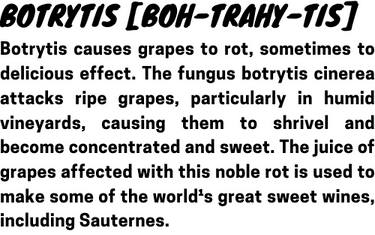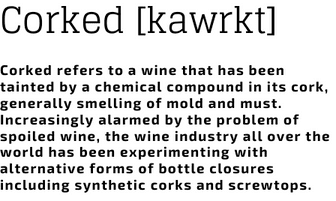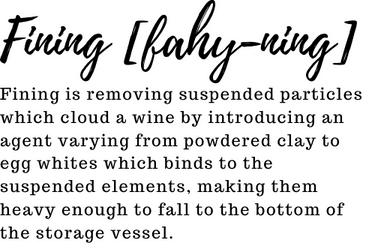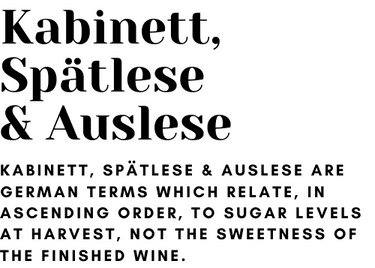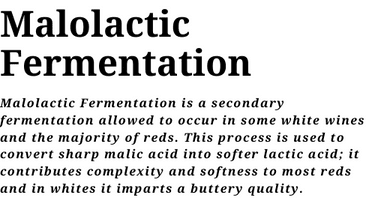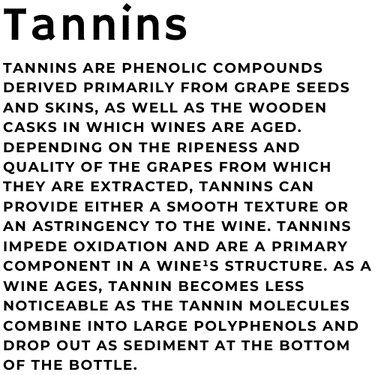Acidity is the natural tartness of grapes, giving a refreshing quality and preventing blandness. It is one of the main components in the structure of wine. The most common acids are tartaric, malic, lactic and citric.
Alcohol level is the amount of alcohol by volume. Wine generally ranges from 7% to 14%, with an average of 11% to 12%; fortified wines may reach 21%. By contrast, beer averages between 4 and 5%, and spirits generally start at 40%.
Appellation is a geographical designation of origin. The system used in the States defines AVAs (or American Viticultural Areas). Acronyms for systems used elsewhere include AC or AOC (France); DOC or DOCG (Italy); DO or DOC (Spain); DO or IPR (Portugal).
Aroma is the combination of primary scents that evolves into bouquet as wine ages.
Astringency is mainly associated with red wines, due to levels of tannin; it is experienced on the palate as a rough, drying sensation.
Balance is the harmonious interplay of components in a wine. For example, acidity balances sweetness; fruit balances oak; alcohol balances flavor.
Barrel aging refers to keeping wine in a wooden barrel after fermentation and before bottling. Wood is porous and allows the wine to mature in controlled interaction with its environment; the wood may also provide flavor.
Barrel-Fermented identifies wines fermented in oak barrels rather than stainless steel tanks or other vessels.
Barrique is a small (59-gallon) barrel for aging wine.
Blanc de Blancs is white wine made from white grapes; Blanc de Noirs is white wine from dark-skinned grapes.
Body is the tactile impression of weight or fullness of wine on the palate.
Bouquet is the complex of fragrances that develops in a wine as it matures.
Carbonic Maceration is the fermentation of whole rather than crushed grapes, resulting in light, fruity wines.
Cava is the Catalàn word for cellar, and refers to sparkling wines made in Spain.
Cepage is French for vine variety.
Climate is a critical influence on the production of good-quality wine grapes. Climate includes the level of heat, sunshine, rainfall and wind. Each grape variety has specific conditions of climate which suit it best.
Cremant is a term used to describe French sparkling wines made outside of the Champagne region, but employing the méthode Champenoise in their production. Crémants are produced throughout France, most notably in Alsace and the Loire.
Cru is the French term for rank or level, (often translated as ³growth²), often used to define a hierarchy of vineyards within appellations. In most Bordeaux classifications, premier cru classé is the top rank. In Burgundy, premier cru vineyards are one level below grand cru.
Cuvee is a blend of wines.
Decanting is gently pouring wine from the bottle into another container to enhance aeration and permits removal of sediment.
Dry describes a lack of perceptible sweetness. In dry wines, all or most of the sugar is fermented into alcohol. Brut is a French term for dry Champagne; extra-dry sparkling wines are actually sweeter than brut; demi-sec refers to a medium-sweet to sweet wine. Trocken is the German word for dry; halbtrocken is half-dry. Secco is Italian for dry, abboccato for slightly sweet.
Fat describes a full-bodied wine, where the level of acidity is lower than the perceptible sweetness or alcohol.
Fermentation is the process during which yeast transforms the sugar of grape juice (or a mash of grains) into alcohol.
Filtering is often used to remove yeast cells and other particles from wine after fermentation or prior to bottling.
Finish is the wine¹s tactile and flavor impression left in the mouth after swallowing. In the finest wines, the finish should be long and lingering.
Fortified connotes the addition of spirits to wine: to raise the level of alcohol, or to stop fermentation and thereby maintain the natural sweetness of the grapes.
Glycerin is a by-product of fermentation most noticeable in higher alcohol and late-harvest wines, giving a smooth tactile impression.
Late-Harvest refers to sweet wines made from extra-ripe grapes.
Length describes wine with a prolonged flavor and feel in the mouth.
Lees are the sediment‹consisting of dead yeast cells, grape pulp, seeds and pigment‹that drop to the bottom of a vessel during and after a wine¹s fermentation. Sur lie is a French phrase which refers to extended contact of wine with the lees, which imparts additional flavor (described in wine jargon as leesy).
Maceration is the steeping of grape skins and seeds within the must to extract phenolics.
Meritage represents white or red wines from a California winery incorporating a blend of varieties traditionally used in Bordeaux, France.
Méthode champenoise is French for ³Champagne method,² referring to the production of sparkling wines both in Champagne and elsewhere. The key step in the méthode Champenoise is the inducement of a secondary fermentation inside the bottle, by adding a small amount of yeast and sugar to a ³base wine² and re-corking the bottle, trapping the carbon dioxide from the second fermentation inside to give the wine its bubbles.
Must is crushed grapes ready to be fermented, or in the process of fermenting.
Negociant is the French word for merchant.
Nose refers to the aroma of a wine, or to the act of smelling the wine.
Oxidized describes wines that have spoiled or become brown due to oxygen.
Phenolics are chemical compounds found in wines; they include tannins, color pigments and flavor compounds.
Reserva in Spain and Riserva in Italy are legally defined terms describing the aging requirements of wines in particular regions. In most other countries, ³reserve² designations do not have legal definitions; they may refer to a selection or lot, or simply be part of a brand name.
Residual Sugar refers to a percentage of natural sugars left in a finished wine after it has gone through fermentation. It is usually expressed as a percentage of grams of sugars per liter of finished wine. A higher percentage of RS generally marks a sweeter-tasting wine.
Structure refers to the interaction of components which contribute to a wine¹s tactile sensation, including acidity, glycerin, alcohol and tannin.
Sulfites are a derivative of the element sulfur, widely used in winemaking, though most wineries keep their applications to a minimum. Sulfur may be sprayed in the vineyard as a preventive against diseases, pests and mildew. Sulfites may be used in the winery to clean and sterilize equipment, to kill off bacteria that could harm the wine, to prevent browning in the juice, to inhibit native yeasts on the grapes, or to guard against spoilage at bottling. Sulfites are also a natural by-product of fermentation, and most wines contain very low levels of added sulfites. By law, any wine with sulfites higher than 10 ppm must state ³contains sulfites² on the label.
Terroir describes the environment or a particular vineyard, including elements of soil, climate and aspect. The French term ³gout de terroir² refers to the characteristic expression of a specific vineyard in a wine.
Varietal Character refers to the combination of aromas and tactile impressions typically offered by a particular grape variety.
Vintage is the year in which the grapes were picked, and also refers to the picking process.
Vitis Vinifera is the genus and species of grapevine responsible for producing grapes that make the world¹s best wines‹cabernet sauvignon, chardonnay, pinot noir, riesling, sauvignon blanc, etc.
Yeasts are one-celled organisms that, in winemaking, convert sugars into alcohol.
Yield is the quantity of grapes or wine produced in a given area‹often stated as tons/acre or hectoliters/hectare (hl/ha)
|
 |
...


